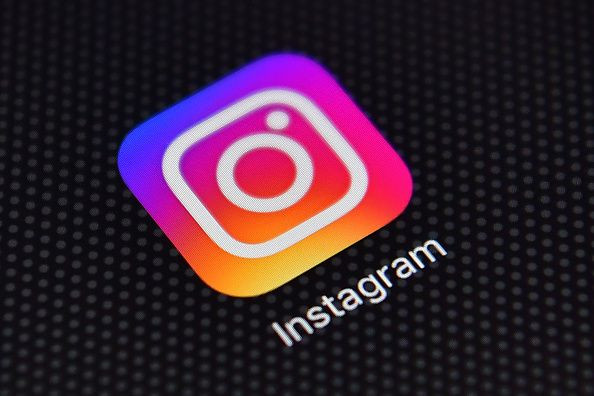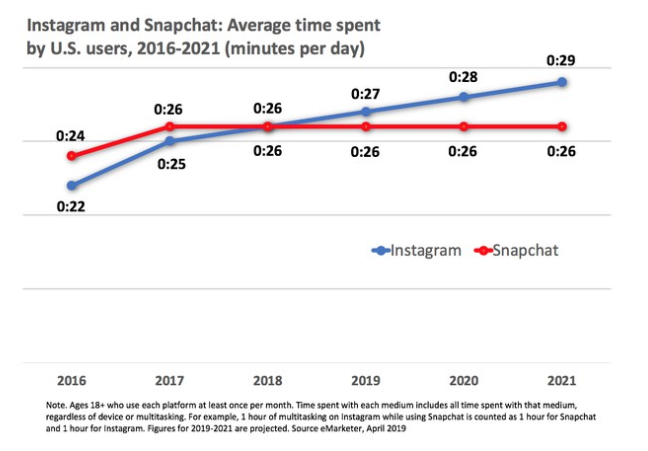Instagram Is More Engaging Than Snapchat, Report Claims

If there's one advantage Snap (NYSE:SNAP) has had over its bigger competitors like Instagram, it's that its users spend more time in the app everyday. Snap even highlighted its engagement in its first-quarter earnings report, noting average time spent per user per day "remains over 30 minutes."
But that engagement might not be increasing. Time spent among U.S. users age 18 and older is expected to remain flat through 2021, according to an eMarketer report out this week. Meanwhile, analysts expect Facebook's (NASDAQ:FB) Instagram to steadily increase its engagement over the same period, surpassing Snap's average time spent per user this year.

Readers may notice eMarketer's estimate is below Snap's reported 30-plus minutes per day for its average users. eMarketer's analysis includes only U.S. adults aged 18 and over, while Snap also includes users between 13 and 17 years old, which historically spend more time on Snapchat than older users, as well as international users. eMarketer's estimates are most valuable for the trend they show.
Here's what Snap's management has said about its engagement and how Instagram's bigger, more engaged user base in the U.S. might impact its business going forward.
Snap says engagement is growing
During Snap's first-quarter earnings call, management repeatedly mentioned how engagement was increasing. CFO Lara Sweet even noted, "If engagement trends continue in a positive direction, we expect to observe higher infrastructure costs," suggesting a meaningful increase in the amount of time spent and video consumed on the platform.
But when management was asked to specify where engagement growth was coming from, CEO Evan Spiegel said, "We're really seeing it across the board." He neglected to call out any specific features or geographies that might be contributing to the climbing engagement.
Digging into the financials, it looks like Snap is making more headway in international markets than it is at home. Average revenue per user (ARPU) climbed 47% year over year in Europe and 68% in the rest of the world outside of North America. Snap's home continent saw ARPU increase just 34%. That's certainly impacted by its head start in monetizing North American users, but the company still has a lot of room for growth in the region still.
Snap's concentration on improving the Android app will have an outsize impact on engagement internationally, where Android's market share is significantly higher than it is in the U.S.
While international growth in engagement is important and valuable, it's not quite as valuable as increasing engagement in the United States. The U.S. has much greater revenue potential than average markets in the rest of the world, so stagnating user engagement in the U.S. will significantly impact Snap's revenue growth.
Instagram's growing engagement and users
Instagram's growth is one of the biggest reasons users aren't spending more time on Snapchat. Instagram's Stories feature is a copy of Snapchat Stories, and Instagram has also introduced more ways to share privately like Snapchat. As of the start of the year, Instagram had 500 million daily active users for Stories. Combined with 1 billion monthly active users for the app as a whole, it makes Instagram a much more attractive platform for both creators and consumers compared to Snapchat.
Instagram's network effect is showing up in its engagement metrics. Users are able to find more and better content on Instagram than on Snapchat, despite Snap's best efforts with new features in its Discover section, including Snap Originals.
Unlike Snap, which shares revenue with creators in the Discover section, Instagram doesn't have a big revenue-sharing aspect to its business. Last quarter, Snap gave $35 million to its content partners as part of its revenue-sharing agreements. That's about 11% of its total revenue. Instagram is fully relying on the network effect to attract creators, making its monetization efforts more lucrative for its parent company.
Facebook is still in the early stages of monetizing Instagram Stories. As engagement and total users grow, Facebook is poised to win big U.S. ad budgets over Snap as marketers try to reach a broad and engaged user base. (Facebook's ad-targeting data and ad-buying platform help, too.) Snap, with its plateauing user engagement in the U.S., could struggle to grow ad revenue in the long term.
This article originally appeared in the Motley Fool.
Randi Zuckerberg, a former director of market development and spokeswoman for Facebook and sister to its CEO, Mark Zuckerberg, is a member of The Motley Fool's board of directors. Adam Levy owns shares of Facebook. The Motley Fool owns shares of and recommends Facebook. The Motley Fool has a disclosure policy.





















